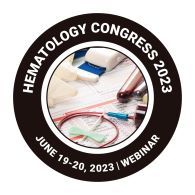Thrombosis and Coagulation
Coagulation mechanism involves in stopping the flow of blood due to an injured or defective vessel wall. The change within the blood into an insoluble gel when injured is blood coagulation. The Coagulation factors are characterized by procoagulatory and anticoagulatory which are in balanced state under normal conditions. The fibrinolytic system prevents the blood clots being problematic for the blood components and this process requires phospholipids, calcium and coagulation factors. Thrombosis summarizes as a variation in the clotting capacity of the blood which partially or entirely stops the flow of blood through that vein. Complications of thrombosis can be life-threatening to a person. When blood clots blocks while blood flows through the veins leads to venous thrombosis. Arterial thrombosis is when the blood clot blocks an artery while oxygen-rich blood carried from heart to the body.
Treatment may include-
- Anticoagulants
- Thin tubes and stent helps to open the blocked vessels
- Medicines to prevent clots
Related Conference of Thrombosis and Coagulation
Thrombosis and Coagulation Conference Speakers
Recommended Sessions
- Blood Disorders Diagnosis & Treatment
- Blood Transfusion
- Case reports of Hematology
- Cell Therapy
- COVID-19 and Hematology
- Disorders of Vascular Bleeding
- Hematology
- Hematology Oncology
- Immunohematology
- Leukaemia and Lymphoma
- Multiple Myeloma, Amyloidosis, and Stem Cell Transplantation
- New Drug Development in Hematology
- Patient Blood Management
- Pediatric Hematology
- Stem Cell Research
- Thalassemia
- Therapeutic Apheresis
- Thrombosis and Coagulation
- Transfusion Medicine
- Transfusion Transmissible Infections
Related Journals
Are you interested in
- Biomarkers in Hematology and Oncology - Hematology Congress 2026 (Germany)
- Blood Disorders: Diagnosis and Treatment - Hematology Congress 2026 (Germany)
- Cancer Genomics & Metabolomics - Hematology Congress 2026 (Germany)
- Case Reports in Hematology - Hematology Congress 2026 (Germany)
- Clinical Haematology - Hematology Congress 2026 (Germany)
- Cord Blood Transplantation - Hematology Congress 2026 (Germany)
- Digital Imaging in Hematology - Hematology Congress 2026 (Germany)
- Haematology and Pharma Industry - Hematology Congress 2026 (Germany)
- Hematologic Cancers - Hematology Congress 2026 (Germany)
- Hematology and Cardio-Oncology - Hematology Congress 2026 (Germany)
- Hematology Nursing - Hematology Congress 2026 (Germany)
- Hematology: Diagnostics and Screening - Hematology Congress 2026 (Germany)
- Hematopoietic Malignancies - Hematology Congress 2026 (Germany)
- Immunohematology - Hematology Congress 2026 (Germany)
- Neuro-Hematology - Hematology Congress 2026 (Germany)
- Organ Specific Cancer - Hematology Congress 2026 (Germany)
- Pediatric Hematology - Hematology Congress 2026 (Germany)
- Stem Cell Therapy - Hematology Congress 2026 (Germany)
- Transfusion Medicines - Hematology Congress 2026 (Germany)
- Vascular Bleeding Disorders - Hematology Congress 2026 (Germany)

